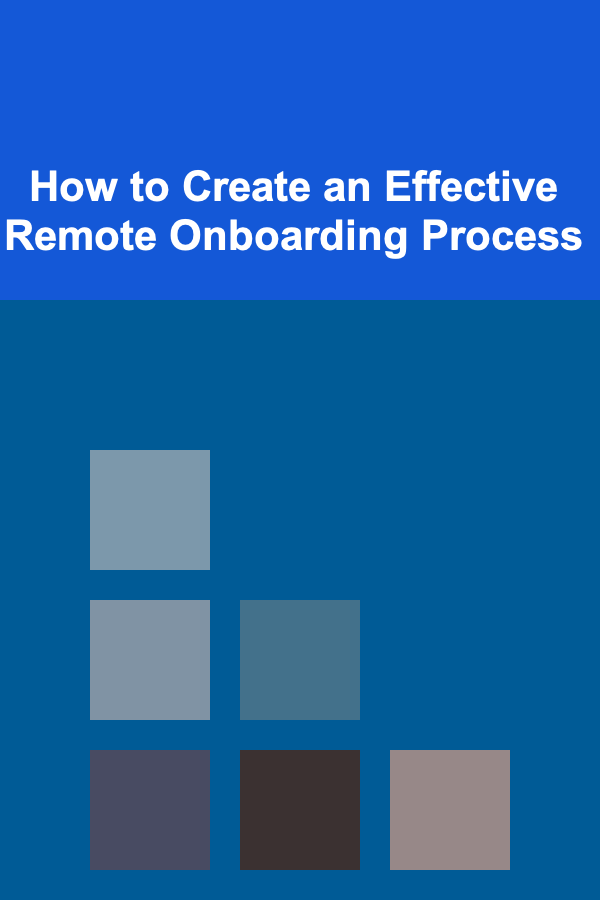
How to Create an Effective Remote Onboarding Process
ebook include PDF & Audio bundle (Micro Guide)
$12.99$5.99
Limited Time Offer! Order within the next:

Onboarding is a critical phase in the employee lifecycle, particularly for organizations embracing remote work. A well-structured onboarding process not only enhances new hires' experiences but also sets the foundation for their long-term success within the company. In a remote environment, where face-to-face interactions are limited, it becomes even more crucial to create an effective onboarding strategy that fosters engagement, builds relationships, and accelerates productivity. This article will outline comprehensive steps to design an effective remote onboarding process.
Understanding the Importance of Effective Onboarding
1.1. Impact on Employee Retention
A structured onboarding process significantly impacts employee retention rates. According to research, organizations with strong onboarding processes improve new hire retention by 82%. When employees feel welcomed, informed, and engaged from day one, they are more likely to stay with the organization long-term.
1.2. Enhancing Productivity
Effective onboarding accelerates employee productivity. New hires who receive proper training and resources can start contributing to projects sooner. A well-thought-out onboarding program helps them understand their roles, responsibilities, and the company's culture, allowing them to navigate their work environment confidently.
Preparing for the Onboarding Process
2.1. Setting Clear Objectives
Before creating an onboarding process, it's essential to establish clear objectives. Consider the following questions:
- What do you want new hires to achieve in their first week, month, and quarter?
- How will you measure their progress and success?
- What key information do new hires need to know about the organization?
Setting specific goals ensures that everyone involved in the onboarding process understands the desired outcomes.
2.2. Creating an Onboarding Team
Form an onboarding team that includes various stakeholders, such as HR representatives, department managers, and current employees. This collaborative effort will help ensure that all perspectives are considered, leading to a well-rounded onboarding experience.
Developing an Onboarding Plan
3.1. Structured Timeline
A structured onboarding plan should outline the timeline for new hires. This plan typically spans several weeks, detailing what new employees will accomplish each week. Below is a sample timeline:
Week 1: Orientation and Introduction
- Company overview
- HR policies and procedures
- Setting up technology and tools
Week 2: Role-Specific Training
- Job-specific training sessions
- Meeting with team members
- Shadowing opportunities
Week 3: Integration into the Team
- Participation in team meetings
- Initial projects and tasks
- Feedback sessions with managers
A clear timeline helps guide the onboarding process and keeps both new hires and their managers accountable.
3.2. Customized Onboarding Experiences
Recognize that each role may require different onboarding experiences. Tailor the onboarding plan based on job function, level, and team dynamics. Customization allows new hires to focus on relevant skills, promoting a faster learning curve.
Utilizing Technology for Remote Onboarding
4.1. Video Conferencing Tools
Video conferencing platforms like Zoom, Microsoft Teams, or Google Meet are essential for remote onboarding. These tools facilitate face-to-face interaction, enabling new hires to connect with their teams and engage in training sessions.
- Orientation Meetings: Conduct virtual orientation sessions using video conferencing, giving new hires a chance to meet key team members.
- Interactive Workshops: Utilize breakout rooms for small group discussions during training to promote engagement.
4.2. Onboarding Platforms
Consider utilizing specialized onboarding platforms designed to streamline the onboarding process. Some popular options include:
- BambooHR: Offers user-friendly onboarding tools that include checklists, document management, and communication features.
- WorkBright: Focuses on remote onboarding with features such as e-signatures and automated compliance documentation.
These platforms can enhance the efficiency of your onboarding process while providing a centralized location for all onboarding materials.
Creating Engaging Onboarding Content
5.1. Pre-Onboarding Activities
Before the official start date, consider engaging new hires through pre-onboarding activities:
- Welcome Emails: Send a personalized welcome email outlining the first day's agenda, important documents they need to review, and access to onboarding platforms.
- Online Learning Modules: Provide access to online training resources or courses relevant to their role.
These activities help build excitement and prepare new hires for their upcoming journey.
5.2. Orientation Sessions
Orientation sessions lay the groundwork for new hires. Here are some components to include:
- Company Culture: Discuss the company's mission, values, and culture to familiarize new hires with the organizational environment.
- Overview of Teams: Introduce various departments and their functions to help new employees understand the organizational structure.
- Training on Tools and Software: Provide hands-on training for tools and software they will use daily.
Make these sessions interactive by encouraging questions and participation.
Facilitating Social Connections
6.1. Assigning Buddies or Mentors
Assigning a buddy or mentor to new hires can foster social connections and provide support during the onboarding process. This individual should be a seasoned team member who can guide the newcomer, answer questions, and offer insights into the company culture.
6.2. Virtual Team Building Activities
Incorporate virtual team-building activities to strengthen relationships among team members:
- Icebreakers: Use icebreaker games during team meetings to encourage interaction and engagement.
- Themed Virtual Events: Organize events such as trivia nights or lunch-and-learns to create informal bonding opportunities.
Fostering connections helps new hires feel part of the team, reducing feelings of isolation.
Providing Ongoing Support and Feedback
7.1. Regular Check-ins
Schedule regular check-ins between new hires and their managers to discuss progress, challenges, and feedback. Weekly or bi-weekly check-ins offer a platform for open communication, allowing managers to address concerns promptly and provide encouragement.
7.2. Collecting Feedback
Solicit feedback from new hires about their onboarding experience. Use surveys or one-on-one discussions to gather insights into what worked well and areas for improvement. This feedback loop not only helps enhance the onboarding process but also demonstrates that the organization values employee input.
Evaluating the Onboarding Process
8.1. Key Performance Indicators (KPIs)
Establish KPIs to evaluate the effectiveness of your remote onboarding process. Some potential KPIs include:
- Time to Competency: Measure how long it takes for new hires to reach full productivity.
- Retention Rates: Analyze turnover rates within the first year of employment.
- Employee Satisfaction Surveys: Gauge new hire satisfaction with the onboarding process.
Regularly assess these metrics to identify trends and areas for improvement.
8.2. Continuous Improvement
Onboarding should be viewed as an ongoing process rather than a one-time event. Continually refine your onboarding program based on feedback and performance data. Stay informed about industry best practices and emerging technologies to enhance your approach.
Best Practices for Remote Onboarding
- Be Inclusive: Ensure your onboarding process considers diverse backgrounds and experiences.
- Personalize the Experience: Tailor onboarding plans to suit individual needs and roles for greater impact.
- Communicate Clearly: Maintain transparent communication throughout the onboarding process to set expectations.
- Utilize Visuals: Use visuals, infographics, and videos to convey information effectively and keep new hires engaged.
Conclusion
Creating an effective remote onboarding process is essential for ensuring new hires feel welcomed, engaged, and prepared to contribute to their teams. By investing time and resources in developing a comprehensive onboarding strategy, organizations can foster positive employee experiences, enhance productivity, and improve retention rates.
As remote work continues to evolve, so too should onboarding practices. Embrace the challenge of adapting to new technologies and methodologies while prioritizing the human element of onboarding. With a thoughtful approach, organizations can turn remote onboarding into an enriching experience that lays the groundwork for long-term success.
Reading More From Our Other Websites
- [Organization Tip 101] Common Mistakes to Avoid When Applying Textured Paint
- [Home Security 101] How to Safeguard Your Pool Area with Effective Home Security Measures
- [Personal Care Tips 101] How to Apply a Hair Mask for Curly Hair
- [Organization Tip 101] How to Choose the Right Nail Gun for Trim Work in Your Home
- [Toy Making Tip 101] Family-Friendly Crafting: Step‑by‑Step Guides to Build Toys Together
- [Home Storage Solution 101] How to Maximize Your Small Pantry Storage with Smart Shelving and Containers
- [Personal Investment 101] How to Invest in Green and Sustainable Companies
- [Personal Care Tips 101] How to Use Body Wash for Sensitive Skin
- [Personal Care Tips 101] How to Use Hair Gel to Achieve a Sleek, Polished Look
- [Personal Care Tips 101] How to Prevent Nail Polish from Chipping

How to Budget for Home Security and Safety Features
Read More
How to Handle Rental Property Taxes and Reporting
Read More
How to Keep Your Home Safe During the Summer Months
Read More
How to License Your Deep Learning Models and Earn Passive Income
Read More
How to Organize Your Pantry for Easy Access and Space Efficiency
Read More
How To Build a Strong Foundation for Social Skills
Read MoreOther Products

How to Budget for Home Security and Safety Features
Read More
How to Handle Rental Property Taxes and Reporting
Read More
How to Keep Your Home Safe During the Summer Months
Read More
How to License Your Deep Learning Models and Earn Passive Income
Read More
How to Organize Your Pantry for Easy Access and Space Efficiency
Read More